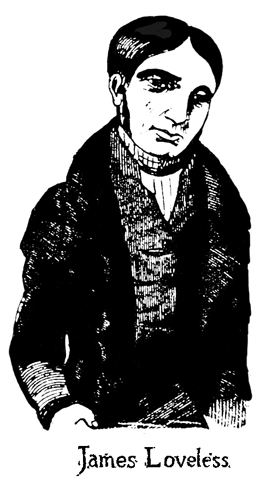Together with five other men (George Loveless – his brother, Thomas Standfield – his sister Dinniah's husband, John Standfield – his nephew, James Brine and James Hammett) James formed an alliance of farm workers in 1933 to attempt to improve working conditions and wages. They called themselves the Friendly Society of Agricultural Labourers. This is now recognized as the world's first trade union. As early as 1830 during local riots in Piddletown, James had been singled out by Squire Frampton as a firebrand.
The men were arrested on February 24, 1834 and marched to Dorchester on charges of being present at an initiation ceremony where illegal oaths were administered during a meeting of their Friendly Society. They were tried on March 17, 1834 where they were found guilty and sentenced to seven years of convict labour in Australia. They set said on April 11, 1834 and after four months, arrived in Sydney, Australia. James was assigned to a farm at Strathallan.
Petitions and demonstrations were organized, including a mass gathering at Copenhagen Fields, where thousands of protesters marched peacefully across London to Whitehall. Under this pressure, the home secretary, Lord John Russell, granted the men conditional pardons in June 1835, followed by full pardons in March 1836. News of the pardons reached Sydney at the end of August 1836. It took some time for the men to be made aware of their freedom, and so it was some time before they all arrived back in England. James Loveless left Sydney in September 1837 along with Thomas and John Standfield, and James Brine. It took them until March 1838 to arrive back in England, two full years after receiving their pardons. They were given a hero's reception.
Upon their return, the Dorchester Committee raised enough money to obtain leaseholds on two farms in Essex, at Tilegate Green and Greensted where the families moved in August 1838. Within a few years, the Martyrs began emigrating to Ontario, Canada (all but John Hammett). James Loveless emigrated to with his brother George in 1844, settling in London Township. There is some evidence that James may have established the first temperance hotel in London (Ont.) in 1851, although he does not appear to have ever owned land in Canada. He was listed in Railton's 1856 directory as the sexton of two Wesleyan Methodist Churches (North Street and St. James Street).
The Tolpuddle Martyrs are considered to be icons of the trade union movement; a festival is organized annually in their honour by the Trades Union Congress at the Martyrs Museum in Tolpuddle, England.
Together with five other men (George Loveless – his brother, Thomas Standfield – his sister Dinniah's husband, John Standfield – his nephew, James Brine and James Hammett) James formed an alliance of farm workers in 1933 to attempt to improve working conditions and wages. They called themselves the Friendly Society of Agricultural Labourers. This is now recognized as the world's first trade union. As early as 1830 during local riots in Piddletown, James had been singled out by Squire Frampton as a firebrand.
The men were arrested on February 24, 1834 and marched to Dorchester on charges of being present at an initiation ceremony where illegal oaths were administered during a meeting of their Friendly Society. They were tried on March 17, 1834 where they were found guilty and sentenced to seven years of convict labour in Australia. They set said on April 11, 1834 and after four months, arrived in Sydney, Australia. James was assigned to a farm at Strathallan.
Petitions and demonstrations were organized, including a mass gathering at Copenhagen Fields, where thousands of protesters marched peacefully across London to Whitehall. Under this pressure, the home secretary, Lord John Russell, granted the men conditional pardons in June 1835, followed by full pardons in March 1836. News of the pardons reached Sydney at the end of August 1836. It took some time for the men to be made aware of their freedom, and so it was some time before they all arrived back in England. James Loveless left Sydney in September 1837 along with Thomas and John Standfield, and James Brine. It took them until March 1838 to arrive back in England, two full years after receiving their pardons. They were given a hero's reception.
Upon their return, the Dorchester Committee raised enough money to obtain leaseholds on two farms in Essex, at Tilegate Green and Greensted where the families moved in August 1838. Within a few years, the Martyrs began emigrating to Ontario, Canada (all but John Hammett). James Loveless emigrated to with his brother George in 1844, settling in London Township. There is some evidence that James may have established the first temperance hotel in London (Ont.) in 1851, although he does not appear to have ever owned land in Canada. He was listed in Railton's 1856 directory as the sexton of two Wesleyan Methodist Churches (North Street and St. James Street).
The Tolpuddle Martyrs are considered to be icons of the trade union movement; a festival is organized annually in their honour by the Trades Union Congress at the Martyrs Museum in Tolpuddle, England.
Bio by: Sheilia W.
Gravesite Details
There is no marker or monument on the grave.
Family Members
Advertisement



